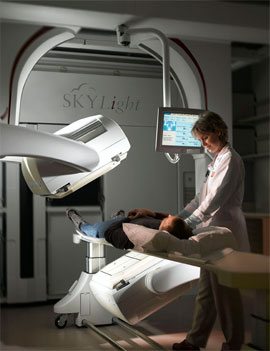 What is Nuclear Medicine?
What is Nuclear Medicine?
Nuclear medicine is a branch of medicine and medical imaging that uses the nuclear properties of matter in diagnosis and therapy. Many procedures in nuclear medicine use pharmaceuticals that have been labeled with radionuclides (radiopharmaceuticals). These are introduced into the patient's body by injection, swallowing or inhalation. The amount given is very small, designed to be maximally safe, and should have no harmful effects.
It's purpose is to go to a specific place in the body where there could be disease or abnormality. The radioactive part of the pharmaceutical that emits radiation, known as gamma rays (similar to x-rays), is then detected using a special camera called a gamma camera. This type of camera allows the nuclear medicine physician to see what is happening inside the patient's body.
Nuclear medicine differs from most other imaging modalities in that the tests primarily show the physiological function of the system being investigated as opposed to the anatomy. In simpler terms, it enables us to see how the organ being studied actually functions as opposed to just what it looks like.
What Will Take Place During the Exam?
During this imaging procedure, the patient is asked to lie down on a bed and the gamma camera is placed over their body. Pictures are then taken and can vary in duration depending on the information needed. These images allow nuclear medicine physicians to diagnose the patient's disease. In therapy, radionuclides are administered to treat disease or provide palliative pain relief. For example, administration of Iodine-131 is often used for the treatment of hyperthyroidism and thyroid cancer.
What are Thompson Health's Nuclear Medicine Services?
Services at Thompson Health include cardiac diagnostic studies, cancer detection studies, as well as bone, hepatobiliary, thyroid, parathyroid, gastric, renal and other less common procedures. Thompson Health has a new state-of-the-art gamma camera with a more open design to offer easier patient access and higher patient weight limits. This equipment is faster and more sensitive, enabling more accurate test results and faster data analysis.